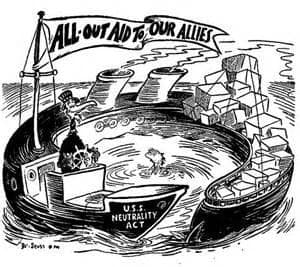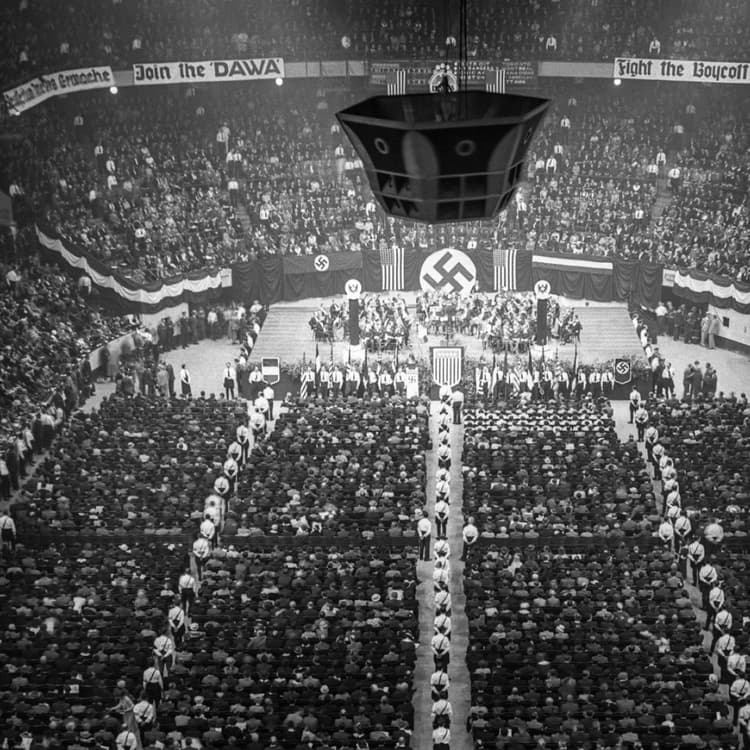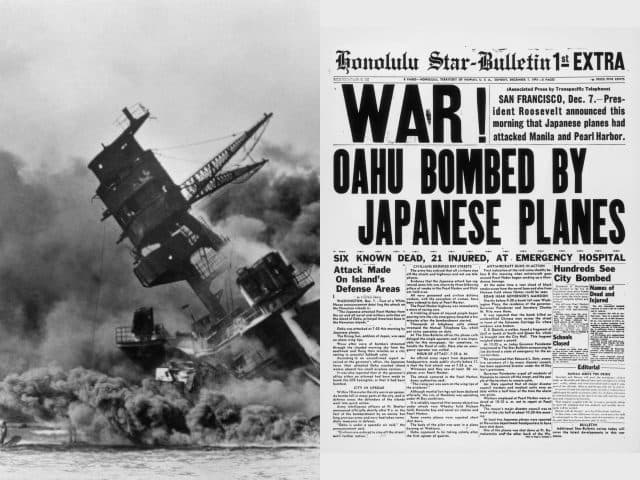Interwar Foreign Policy
Grace Lewis
8 min read
Listen to this study note
Study Guide Overview
This study guide covers the interwar period and the road to WWII, focusing on US foreign policy. It examines America's initial isolationism, the rise of totalitarianism, the Good Neighbor Policy, the Neutrality Acts, and the gradual shift towards interventionism through Cash and Carry and the Lend-Lease Act. Finally, it explores the attack on Pearl Harbor and the US entry into the war.
#AP US History: Interwar Period & Road to WWII 🚀
Hey there, future AP historian! Let's get you prepped for the exam with a super-focused review of the interwar period and the lead-up to World War II. We'll break it down, make it memorable, and get you feeling confident! 💪
#Post-WWI: A Return to "Normalcy"?
#The US Steps Back (Kind Of)
- Return to Normalcy: President Harding's slogan meant less European entanglement, but not complete isolation.
- Limited Engagement: The US still had colonies, wanted global trade, and sought to prevent future wars through treaties.
#Attempts at Peace and Stability
- Washington Conference (1921): Tried to limit naval arms races, with a focus on battleship ratios.
*
US, UK > Japan > France, Italy
*
US aimed to curb Japanese naval power in the Pacific.
- Kellogg-Briand Pact (1928): A promise to avoid war, but toothless due to lack of enforcement. 🚫
*
Think of it like a pinky promise between countries – nice in theory, but not very effective.
#The Dawes Plan: A House of Cards 🃏
- US Banks loaned money to Germany → Germany paid reparations to UK & France → UK & France repaid US banks for WWI loans → repeat.
This cycle worked until the Great Depression hit the US, and the whole thing collapsed.
Practice Question
Multiple Choice:
-
The Washington Naval Conference of 1921 was primarily intended to: (A) Establish a new international peacekeeping organization. (B) Limit the naval arms race among major powers. (C) Promote free trade and economic cooperation. (D) Resolve territorial disputes in Europe.
-
The Kellogg-Briand Pact of 1928 is best characterized as: (A) An effective treaty that prevented future wars. (B) A symbolic agreement lacking enforcement mechanisms. (C) A military alliance between the United States and European powers. (D) A plan for economic recovery after World War I.
Short Answer Question:
Briefly explain the main goals of the Dawes Plan and why it ultimately failed.
#American Isolationism & The Rise of Totalitarianism
#The World Goes Dark 🌑
- Totalitarian Leaders: Hitler (Germany), Mussolini (Italy), Stalin (USSR), and Tojo (Japan) rose to power, embracing nationalism, militarism, and expansion. *
Totalitarianism = state control of all aspects of life
- Expansion: These nations began expanding their territories in the 1930s.
#US Stays Out (For Now)
- Isolationism: Despite concerns, most Americans supported staying out of international conflicts.
- Key Events: Japan invaded China, and Germany invaded Poland, starting WWII, but the US remained neutral.
#Good Neighbor Policy
#Focus on Latin America
- No Intervention: FDR pledged not to interfere in Latin American internal affairs.
- Arbitration: Committed to resolving disputes through negotiation.
- Hemispheric Unity: Warned that any European aggression would be met with a united response from the Americas.
#Neutrality Acts
#Keeping the US Out of War
- Restricted Trade: Made it difficult to trade with warring nations to avoid WWI-like entanglements.
Remember: These acts were designed to keep the US neutral, but they also limited our ability to help allies.
Practice Question
Multiple Choice:
-
The Good Neighbor Policy, initiated by President Franklin D. Roosevelt, primarily focused on: (A) Increasing US military presence in Latin America. (B) Promoting economic development in Asia. (C) Improving relations with Latin American countries. (D) Isolating the United States from international conflicts.
-
The Neutrality Acts of the 1930s were primarily designed to: (A) Provide financial aid to Allied nations. (B) Prevent the United States from being drawn into another war. (C) Increase US military preparedness. (D) Encourage trade with both Allied and Axis powers.
Short Answer Question:
Explain how the Neutrality Acts reflected the prevailing sentiment of isolationism in the United States during the 1930s.
#US Assistance to the Allies (Slowly but Surely)
#Cash and Carry
- British Purchases: Allowed the UK to buy war materials from the US, but they had to pay cash and transport it themselves. *
This was a way to help without direct involvement.
#Lend-Lease Act
- Financial and Material Aid: Allowed the US to lend money and materials to the UK, China, and the USSR. *
This was a major step away from neutrality.
#Selective Service Act (1940)
- First Peacetime Draft: The US began mobilizing for war.
#Opposition to Intervention
- America First: Led by Charles Lindbergh, this group advocated for isolationism. *
Don't confuse this with the 'America First' policies of other eras - they are not the same!
#The Catalyst: Pearl Harbor
- December 1941: The Japanese attack on Pearl Harbor led to full-scale US involvement in WWII.

#Nazism and the United States
#The American Bund
- Pro-Nazi Group: Promoted fascist ideology in the US, led by Fritz Julius Kuhn.
- Public Rallies: Held large rallies and tried to recruit German-Americans. *
This highlights the presence of extremist ideologies in the US during this time.

#A pro-Nazi rally in Madison Square Garden
#The US is Pushed Into War
#Pearl Harbor: The Breaking Point
- "Day of Infamy": FDR's description of the attack.
- Declaration of War: The US declared war on Japan, Italy, and Germany.

Practice Question
Multiple Choice:
-
The Lend-Lease Act was primarily intended to: (A) Provide direct military assistance to Allied nations. (B) Offer financial aid and war materials to Allied nations. (C) Maintain strict neutrality by restricting trade with all warring nations. (D) Establish a military alliance between the United States and Great Britain.
-
The attack on Pearl Harbor on December 7, 1941, is best described as: (A) A minor skirmish that had little impact on US policy. (B) The event that triggered the United States' entry into World War II. (C) A successful attempt by the United States to intimidate Japan. (D) A pre-emptive strike by the United States against Japanese forces.
Free Response Question:
Evaluate the extent to which the United States maintained a policy of isolationism during the period between World War I and World War II. In your response, be sure to address the following:
- The economic and political factors that contributed to the rise of isolationism.
- The ways in which the United States attempted to remain neutral.
- The actions taken by the United States that moved it away from isolationism.
Scoring Rubric:
- Thesis (1 point): Presents a clear, historically defensible thesis that addresses the prompt.
- Contextualization (1 point): Describes the broader context of the interwar period, including the impact of WWI and the Great Depression.
- Evidence (2 points): Provides specific examples of isolationist policies (e.g., Neutrality Acts) and actions that moved the US away from isolationism (e.g., Lend-Lease Act).
- Analysis (2 points): Explains the reasons behind isolationism and the factors that led the US to eventually enter WWII. Demonstrates an understanding of the changing nature of US policy.
- Synthesis (1 point): Connects the interwar period to later developments in US foreign policy, or connects to a different time period.
#Final Exam Focus 🎯
#High-Priority Topics
The shift from isolationism to interventionism
The impact of the Great Depression on international relations
The rise of totalitarian regimes and their impact on US policy
Key legislation: Neutrality Acts, Cash and Carry, Lend-Lease Act
#Common Question Types
- Multiple Choice: Expect questions on specific policies, events, and their causes/effects.
- Short Answer: Be ready to explain the motivations behind US policy decisions.
- Free Response: Focus on evaluating the extent of isolationism and the factors that led to US involvement in WWII.
#Last-Minute Tips
- Time Management: Don't spend too long on any one question.
- Common Pitfalls: Avoid oversimplifying complex issues; show nuanced understanding.
- Strategies: Use your knowledge of key events and policies to support your arguments.
Remember to connect different units – AP questions often combine multiple concepts!
You've got this! Go ace that exam! 🌟
Continue your learning journey

How are we doing?
Give us your feedback and let us know how we can improve





